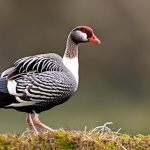Geese invading properties and causing damage has become an increasing problem in many areas. These birds can be a nuisance, leaving behind droppings, damaging lawns, and even posing a threat to human safety. As a result, many property owners are turning to electric fencing as a solution to keep geese out. Electric fencing has proven to be an effective method for deterring geese and preventing them from entering unwanted areas.
Key Takeaways
- Electric fencing is an effective solution for controlling geese and keeping them out of certain areas.
- Benefits of using electric fencing for geese control include affordability, low maintenance, and humane deterrence.
- Electric fencing works by delivering a mild shock to the bird upon contact, which teaches them to avoid the area.
- There are different types of electric fencing suitable for geese control, including permanent and portable options.
- Factors to consider when installing electric fencing for geese include location, voltage, and weather conditions.
Benefits of Using Electric Fencing to Keep Geese Out
There are several advantages to using electric fencing over other methods of geese control. One of the main benefits is its effectiveness. Electric fencing creates a psychological barrier for geese, deterring them from entering the protected area. The mild electric shock they receive when they come into contact with the fence acts as a strong deterrent, teaching them to stay away.
Another advantage of electric fencing is its versatility. It can be easily customized to fit the specific needs of the property owner. Whether it’s a small backyard or a large commercial property, electric fencing can be designed and installed accordingly. Additionally, electric fencing can be easily moved or expanded if needed.
How Electric Fencing Works to Deter Geese
Electric fencing works by delivering a mild electric shock to any animal that comes into contact with it. The fence consists of wires that are connected to an energizer, which sends pulses of electricity through the wires. When a goose touches the fence, it completes the circuit and receives a shock.
Proper installation and maintenance are crucial for the optimal functioning of electric fencing. The fence must be installed at the right height and tension to ensure that geese cannot fly over or crawl under it. Regular inspections and repairs are also necessary to ensure that the fence remains effective.
Types of Electric Fencing Suitable for Geese Control
There are several types of electric fencing available for geese control. One common type is the single-wire electric fence. This consists of a single wire that is installed at the desired height and tension. It is a simple and cost-effective option for deterring geese.
Another type is the multi-wire electric fence. This consists of multiple wires installed at different heights to create a more substantial barrier. The multiple wires make it more difficult for geese to fly over or crawl under the fence.
There are also electric netting options available for geese control. Electric netting consists of interconnected wires that create a physical barrier as well as an electric shock. This type of fencing is particularly effective for keeping geese out of specific areas, such as gardens or ponds.
Factors to Consider When Installing Electric Fencing for Geese
Before installing electric fencing for geese control, there are several important factors to consider. First, it is essential to choose the right location for the fence. This includes identifying the areas where geese are most likely to enter or cause damage. Installing the fence in these strategic locations will maximize its effectiveness.
The materials used for the fence are also crucial. The wires should be made of high-quality materials that can withstand the elements and resist corrosion. Additionally, the energizer should be powerful enough to deliver an effective shock but not strong enough to harm the geese.
Tips for Effective Maintenance of Electric Fencing for Geese Control

To ensure the effectiveness of electric fencing for geese control, regular maintenance is necessary. Inspections should be conducted regularly to check for any damage or wear and tear. Any broken wires or loose connections should be repaired promptly.
It is also important to keep vegetation around the fence trimmed to prevent it from touching the wires and reducing their effectiveness. Additionally, the energizer should be checked regularly to ensure that it is functioning correctly and delivering an adequate shock.
Common Mistakes to Avoid When Using Electric Fencing for Geese Control
There are several common mistakes that people make when using electric fencing for geese control. One common mistake is installing the fence at the wrong height. The fence should be installed at a height that prevents geese from flying over it but also allows other animals, such as deer or rabbits, to pass underneath.
Another mistake is using low-quality materials for the fence. Cheap wires or energizers may not deliver an effective shock, rendering the fence useless. It is important to invest in high-quality materials to ensure the fence’s effectiveness.
Alternatives to Electric Fencing for Geese Control
While electric fencing is an effective method for geese control, there are other alternatives available. Scare tactics, such as decoys or noise-making devices, can be used to deter geese from entering unwanted areas. Physical barriers, such as fences or netting, can also be effective in keeping geese out.
However, these alternatives may not be as effective as electric fencing. Scare tactics can lose their effectiveness over time as geese become accustomed to them. Physical barriers may also be more expensive and less versatile than electric fencing.
Legal Considerations for Installing Electric Fencing for Geese Control
Before installing electric fencing for geese control, it is important to consider the legal requirements and regulations in your area. Some jurisdictions may require permits or have specific guidelines for the installation of electric fencing. It is important to research and comply with these regulations to avoid any legal issues.
Electric Fencing as a Reliable Solution for Keeping Geese Out
In conclusion, electric fencing has proven to be a reliable solution for keeping geese out of unwanted areas. Its effectiveness, versatility, and customization options make it an ideal choice for property owners dealing with geese problems. By understanding how electric fencing works and following proper installation and maintenance practices, property owners can successfully deter geese and protect their properties.
If you’re looking for effective ways to keep geese out of your property, an electric fence can be a great solution. Not only does it provide a physical barrier, but it also delivers a mild electric shock to deter the geese from entering. To learn more about the benefits and installation process of electric fences, check out this informative article on Poultry Wizard: “Turning a Shed into a Chicken Coop”. It provides valuable insights and practical tips that can help you successfully implement an electric fence to keep those pesky geese away.
Meet Walter, the feathered-friend fanatic of Florida! Nestled in the sunshine state, Walter struts through life with his feathered companions, clucking his way to happiness. With a coop that’s fancier than a five-star hotel, he’s the Don Juan of the chicken world. When he’s not teaching his hens to do the cha-cha, you’ll find him in a heated debate with his prized rooster, Sir Clucks-a-Lot. Walter’s poultry passion is no yolk; he’s the sunny-side-up guy you never knew you needed in your flock of friends!







